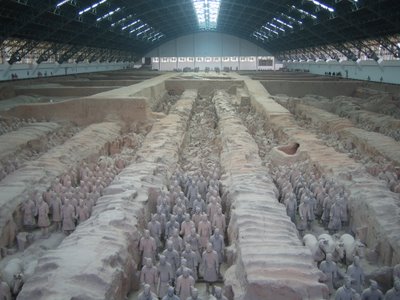Sunday, July 09, 2006
The Daily China Pictures
The "terracotta army" in Xian (Wikipedia entry) is the ultimate attempt to refute the idea that "you can't take it with you." More than 2200 years ago, the Emperor Qin Shi Huang decided that he would need some protection in the afterlife from the many enemies he had accumulated during the, er, life. The scale of the effort was absolutely staggering:
Construction of this mausoleum began in 246 BC and is believed to have taken 700,000 workers and craftsmen 38 years to complete. Qin Shi Huang was interred inside the tomb complex upon his death in 210 BC. According to the Grand Historian Sima Qian, the First Emperor was buried alongside great amounts of treasure and objects of craftsmanship, as well as a scale replica of the universe complete with gemmed ceilings representing the cosmos, and flowing mercury representing the great earthly bodies of water. Pearls were also placed on the ceilings in the tomb to represent the stars and planets, etc. Recent scientific work at the site has shown high levels of mercury in the soil of Mount Lishan, tentatively indicating an accurate description of the site’s contents by Sima Qian....
8,099 figures have thus far been unearthed at the site. These figures include infantry, archers, and officers and are manufactured in a crouching or standing pose. Each figure was given a real weapon such as bronze spears, halberds or swords, or wooden crossbows with bronze fittings. It is believed these weapons date to as early as 228 BC and may have been used in actual warfare. Along with the soldiers and officers, chariots made with great detail and precision were also included as part of Qin Shi Huang’s army.
The terracotta figures were found in three separate pits, with an empty fourth pit also discovered. It is believed that the largest pit, holding over 6,000 figures of infantrymen, chariots and horses, was representative of the First Emperor’s main army. This feature faces east and covers an area of 172,000 square feet. The second pit contains about 1,400 figures of cavalry and infantry along with chariots. This segment is thought to represent a military guard since it is much smaller than the first, measuring 64,500 square feet. The third pit contains the command unit, comprised of high ranking officers, lesser officers, and a war chariot drawn by four horses. It is the smallest of the four and contains 68 figures within a 5,000 square foot area.
The Emperor Qin was not a gentle man, and ordered that the craftsmen who worked on his terracotta army be buried alive when the project was finished, presumably so that they could not similarly arm a subsequent emperor's afterlife. Not surprisingly, within two years of Qin's death in 209 BC, a peasant revolt sacked the tomb and shattered most of the soldiers before caving it in (the warriors in the pictures above have been glued back together). Our guide did not link the revolt and the sacking to the entombment of the workers, but one can't help but wonder the uprising did not include a big contingent of very bitter relatives.
1 Comments:
By Steve Burri, at Mon Jul 10, 12:08:00 AM:
I used to think that this was an incredible display, but I am now realizing that the Left in the U.S. and Western Europe have created much larger armies of terracotta arguments that are on display daily.





